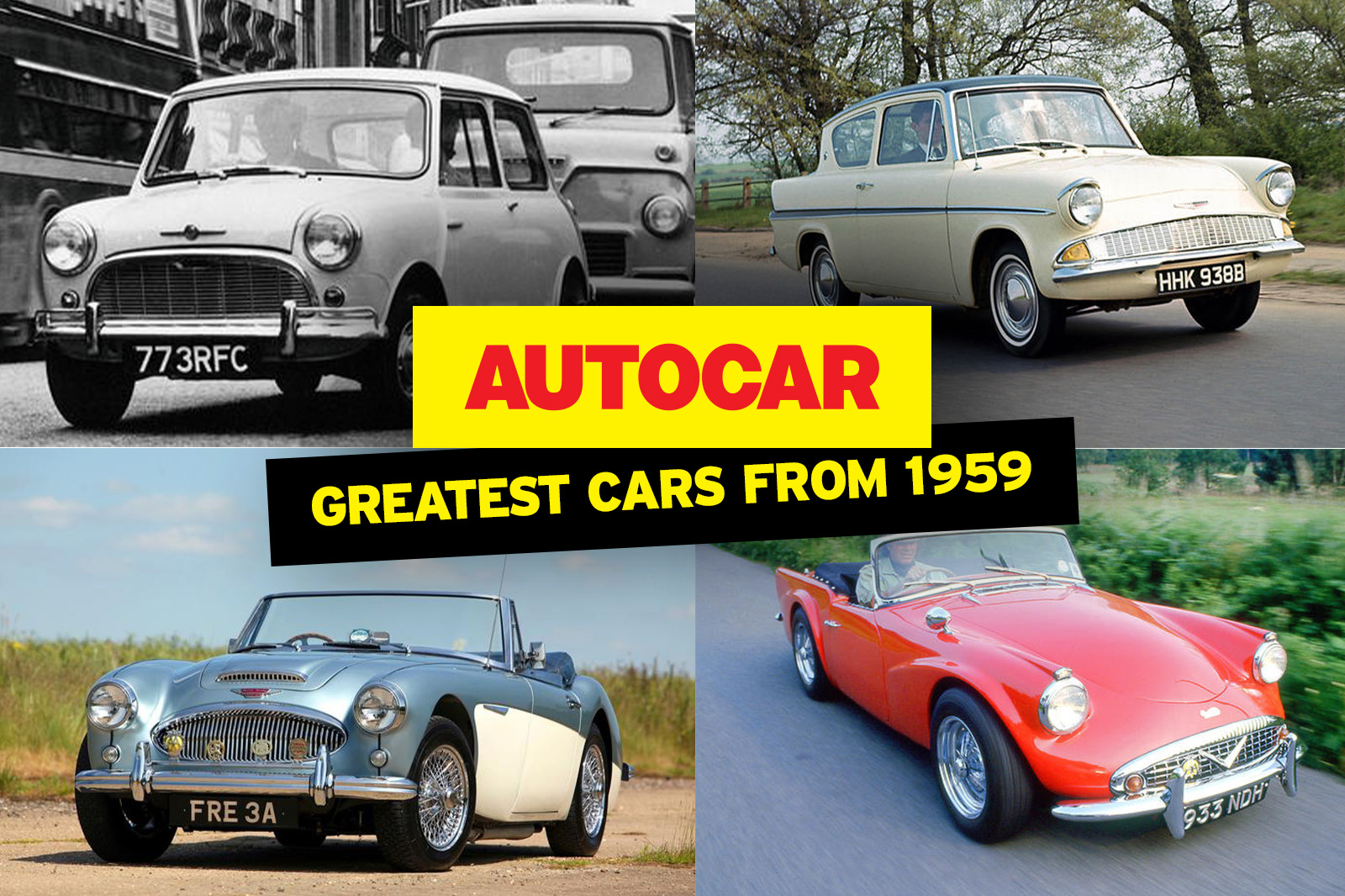All the best cars from 1959
Slide of Mini Cars don’t get more important or iconic than the original Mini, which set the template for small cars that we still have today. With its transversely-mounted engine over the front wheels and the gearbox sharing the same oil, it made for a compact unit that maximised cabin space within the Mini’s 3054 mm (120in) overall length. Light weight meant it also handled well, even if we had to wait for keener performance from the Cooper models. Like so many revolutionary designs, the Mini was the result of one man’s bold vision and that was Alec Issigonis, who had also come up with the Morris Minor. However, it should be remembered the Mini was also the result of British Motor Corporation boss Leonard Lord’s extreme dislike of 'bubble' microcars. Lord wanted an alternative to these cars that had prospered after fuel shortages in the UK caused by the 1956 Suez Crisis. The result was a car that lasted in production for 41 years, with 5.4 million examples built. Slide of Panhard PL 17 Panhard may have been a small company but it never lacked ambition and the PL17 encapsulated that perfectly. It was a more streamlined version of the Dyna and used an all-steel construction to make it more affordable than the aluminium Dyna. Front-wheel drive and a flat-twin engine were reminiscent of the Citroen 2CV, but the PL17’s motor started off as an 851cc unit. That later shrank to 848cc to duck under France’s tax categories at the time. With 50 hp and weighing in at 805kg (1771 lb), this streamlined four-door could reach up to 90mph and 130,000 mostly French buyers reckoned it worth the money until it gave way to the 24CT in the 1964. Slide of Triumph Herald Sleek styling by Michelotti set the Triumph Herald apart from rivals such as the Ford Anglia and Mini. However, underneath that skin was a separate chassis used out of necessity and limited budget. It didn’t stop the Herald finding plenty of eager customers and 951,289 of all types were sold when production ended in 1971. There were also a further 51,000 Vitesse models with a six-cylinder engine. The first Herald on sale was the Coupe, followed a couple of weeks later by the 4-door and convertible. An estate model arrived in 1961 complete with larger 1200 engine, while 1967 saw the restyled 13/60 with its bigger 1.3-liter motor. All stuck with the original transverse leaf rear spring suspension that could catch out the unwary, but the Herald also proved itself an able rally car with works entries and a class win in the 1960 RAC Rally. Slide of Skoda Octavia Skoda named its new for 1959 model Octavia simply because it was the eighth model line to come from its Mladá Boleslav factory. Like the Octavia we have today, the original Octavia was a well-made family car and keenly priced. There was a choice of two- or four-door models and they gained a reputation for good quality and reliability. Starting out with a 1.1-litre engine, the Octavia benefitted from a 51 hp 1.2-litre unit in the Super and TS models. Basic versions for its domestic market were sparsely equipped, but most export cars gained a heater, screen washers and reclining front seats. During its five-year life, 227,258 Octavias were produced. Slide of Ford Anglia The 105E Anglia really was the shock of the new from Ford when it arrived in 1959. Gone were the roly-poly roundness of the previous generation and in came razor sharp lines, fins and a reverse-angle back window. This was a touch of the American dream in a compact size. Like so many Fords before and after it, the Anglia quickly became a darling of the tuning world thanks to its lively 997cc four-cylinder engine and adroit handling. It gave the Mini a tough time on track and rally stages, helping to boost its profile and sales to more than 1 million by the time it bowed out in 1967 to make way for the Escort. In recent years it has attracted new fame as a star in the Harry Potter movies. Slide of Datsun Bluebird The 1959 Datsun Bluebird was not the first in this family line, but it was an all-new model and was the first to be sold in significant numbers in Europe. So, it led the way for the Japanese revolution that took place in the 1970s. To do this, Datsun used the simple formula of building cars that were more rugged and reliable than their Euro counterparts. A 1.0-litre four-cylinder engine was joined by a 1.2-litre unit in 1960 and Datsun offered the car as a sedan or estate, the latter with plenty of luggage room for its compact size. Reflecting the period of its production, the Bluebird was also marketed to women drivers with a ‘Fancy Deluxe’ trim that included curtains, vanity mirror and high heel shoe holder under the dash. Slide of Saab 95 Unveiled in 1959, the Saab 95 was unlike anything else on the road, so normal by Saab standards. Its teardrop shape was inspired by the firm’s aeronautical background, while the sturdy construction ensured i

This is another headline indexed and brought to you by the AUTOMUNDO website.
